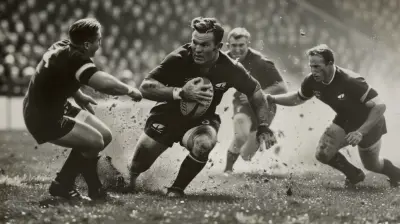Building Aerobic Capacity: The Key to Long-Distance Success
28 December 2024
If you've ever watched a marathon or any endurance event, you've likely marveled at how athletes seem to maintain a steady pace for hours, seemingly without breaking a sweat. What’s the secret to their stamina and ability to perform over long distances? The answer lies in their aerobic capacity.
Building aerobic capacity is crucial for anyone looking to succeed in long-distance sports. Whether you're aiming to run your first marathon, cycle across the state, or swim long distances, aerobic capacity is your golden ticket to going the distance without burning out too quickly.
But what exactly is aerobic capacity, and how can you build it effectively? Let's dive into the nuts and bolts of what makes aerobic capacity so vital for endurance athletes and how you can enhance yours for long-distance success.

What Is Aerobic Capacity?
In simple terms, aerobic capacity refers to the ability of your heart, lungs, and muscles to work together efficiently during prolonged exercise. It’s the foundation of endurance. The more developed your aerobic system, the longer and harder you can exercise without fatiguing.At the core of aerobic capacity is the process of oxygen consumption. Your body uses oxygen to convert fats and carbohydrates into energy for your muscles. When you have a high aerobic capacity, your body can deliver more oxygen to your muscles, allowing you to run, cycle, swim, or perform any prolonged physical activity for extended periods.
Think of aerobic capacity as the size of your engine. The larger your engine, the more fuel (oxygen) it can process, and the longer and more efficiently you can perform.

Why Is Aerobic Capacity Important for Long-Distance Sports?
You might be wondering, "Why should I care so much about aerobic capacity?" The truth is, if you're into any endurance sport, aerobic capacity is your best friend. Here’s why:1. Improved Endurance
As you build aerobic capacity, you can sustain your efforts over more extended periods. This means you won’t hit "the wall" as early in your race or workout. You'll find yourself able to maintain a steady pace without feeling drained halfway through.2. Increased Fat Utilization
Your body has two primary sources of fuel during endurance sports: glycogen (carbohydrates) and fat. When you have a well-developed aerobic capacity, your body becomes more efficient at burning fat for energy. This is crucial because your glycogen stores are limited, and once they’re depleted, fatigue sets in. Relying on fat gives you a more sustainable energy source, allowing you to go the distance.3. Faster Recovery
When you train your aerobic system, your body recovers more quickly between workouts or races. You’ll experience less soreness, and your muscles will repair faster, meaning you can get back to training sooner and with more intensity.4. Better Overall Health
Developing your aerobic capacity doesn’t just improve your sports performance; it also strengthens your heart and lungs, reduces the risk of cardiovascular diseases, and boosts your immune system. It’s like taking care of the engine of a high-performance car — not just to win races but to keep it running smoothly for years.
The Science Behind Aerobic Capacity
Aerobic capacity is often measured by VO2 max, which represents the maximum volume of oxygen your body can use during intense exercise. The higher your VO2 max, the better your aerobic capacity. However, VO2 max is only part of the equation. Just as important is your lactate threshold — the point at which your body starts producing more lactic acid than it can clear away. This leads to muscle fatigue and forces you to slow down.The key to building aerobic capacity is to train in a way that both increases your VO2 max and raises your lactate threshold.

How to Build Aerobic Capacity
Now that we know what aerobic capacity is and why it’s important, let’s talk about how to develop it. Building aerobic capacity doesn't happen overnight, and it requires consistency and a variety of training techniques. Here's a guide to help you on your journey.1. Start With Consistent, Low-Intensity Training
When it comes to aerobic training, slow and steady wins the race. Low-intensity, steady-state workouts form the foundation of aerobic capacity building. These are the sessions where you can hold a conversation while exercising — you’re not going all out, but you’re still putting in the miles or hours.For runners, this might mean long, slow runs at a comfortable pace. Cyclists might opt for long rides at a moderate pace, and swimmers could focus on extended laps at a steady effort. These types of workouts help build your endurance over time by enhancing your body’s ability to transport and use oxygen.
2. Incorporate Interval Training
While low-intensity training builds your base, interval training helps push your limits. By alternating between periods of hard effort and easy recovery, interval training forces your body to work at higher intensities, which boosts your VO2 max and increases your lactate threshold.For example, runners might perform intervals of 3 minutes of hard effort followed by 2 minutes of easy jogging. Cyclists could do the same by alternating between sprints and slower pedaling. Interval training takes you to the edge of your comfort zone and helps you break through performance plateaus.
3. Add Tempo Runs or Threshold Workouts
Tempo runs (or threshold workouts) are done at a pace where you're working hard but not all-out. This is just below your lactate threshold, the point where fatigue starts to build. These workouts are crucial for pushing that threshold higher, allowing you to sustain faster paces for longer periods.A typical tempo run might involve a 10-15 minute warm-up, followed by 20-40 minutes at a comfortably hard pace, and then a cool-down. The goal is to find that sweet spot where you’re working hard but can still maintain the effort without crashing.
4. Cross-Training for Variety
Although you might focus on a specific sport (like running or cycling), incorporating cross-training can be incredibly beneficial for building aerobic capacity. Swimming, rowing, or even hiking can challenge your aerobic system in new ways while giving your primary muscles a break.Cross-training also helps prevent injury by working different muscle groups and reducing repetitive strain on the same areas.
5. Don’t Forget Strength Training
While aerobic capacity is all about your cardiovascular system, your muscles still need to be strong enough to handle prolonged efforts. Strength training can enhance muscular endurance, improve your running economy, and reduce the risk of injury.Incorporate exercises like squats, lunges, and core work into your weekly routine. These exercises target the muscles you use in endurance sports, making them more efficient and resilient.
6. Recovery Is Essential
It’s tempting to go all out every day, but rest and recovery are just as important as your workouts. Adequate rest allows your body to repair and adapt to the stresses of training, which ultimately leads to performance improvements.Make sure to schedule rest days into your weekly routine, and don’t overlook the importance of good sleep and proper nutrition. These will fuel your body’s recovery process and help you come back stronger.
Nutrition and Aerobic Capacity
We can’t talk about endurance and aerobic capacity without touching on nutrition. What you eat plays a massive role in how well your body can perform and recover from long-distance efforts.1. Fueling for Performance
To build and sustain aerobic capacity, your body needs the right fuel. Carbohydrates are essential for stocking up on glycogen, your body's go-to fuel source for high-intensity efforts. But don’t forget about fats — they become your primary fuel source during low-intensity, long-duration activities.Include a balance of complex carbs (like whole grains, fruits, and vegetables), healthy fats (like avocados, nuts, and olive oil), and lean proteins (chicken, fish, tofu) in your diet to support your training.
2. Hydration
Don’t underestimate the power of hydration! Your aerobic system relies on proper hydration to function optimally. Dehydration can reduce blood volume, making it harder for your body to transport oxygen to your muscles. Make it a habit to drink water consistently throughout the day, especially during and after training.Conclusion: Aerobic Capacity Is the Foundation of Endurance Success
Building aerobic capacity is not a quick fix — it’s a long-term investment in your endurance performance. Whether you're a runner, cyclist, swimmer, or any other endurance athlete, focusing on your aerobic system will pay dividends in your ability to go the distance.Start slow, build your base with low-intensity training, and gradually incorporate intervals and tempo work to push your limits. Don't forget strength training, recovery, and proper nutrition to support your body's efforts. With time and consistency, you'll notice improvements in your endurance, speed, and overall performance.
So, lace up those shoes, hop on that bike, or dive into the pool — your aerobic capacity is waiting to be unlocked!
all images in this post were generated using AI tools
Category:
Endurance SportsAuthor:

Uziel Franco
Discussion
rate this article
17 comments
Ford Ortiz
This article beautifully highlights the essence of building aerobic capacity for long-distance success. It’s a reminder that patience and consistent training are vital for our endurance journeys. Thank you for sharing these insights; they inspire both seasoned athletes and newcomers alike to push their limits while enjoying the process.
March 26, 2025 at 11:51 AM

Uziel Franco
Thank you for your thoughtful comment! I'm glad you found the insights helpful and inspiring for all athletes. Your support means a lot!
Paula McClary
This article truly resonates with me! Understanding the importance of aerobic capacity has transformed my training approach. Thank you for sharing such valuable insights that inspire us all to push our limits and achieve long-distance success!
February 5, 2025 at 12:50 PM

Uziel Franco
Thank you for your kind words! I'm glad to hear the article resonated with you and is helping transform your training. Wishing you continued success on your long-distance journey!
Lena McFadden
Boost your aerobic base; it’s the secret weapon for endurance!
February 1, 2025 at 4:36 AM

Uziel Franco
Absolutely! Building your aerobic base is essential for enhancing endurance and improving overall performance in long-distance events.
Callisto Reynolds
Great article! Building aerobic capacity is essential for long-distance athletes. It not only enhances endurance but also improves overall performance. Incorporating structured training, proper nutrition, and recovery strategies can make a significant difference. Excited to implement these insights into my training routine!
January 26, 2025 at 12:03 PM

Uziel Franco
Thank you! I'm glad you found the article helpful. Best of luck with your training!
Maribel Fuller
Building aerobic capacity is like finding the cheat code for distance running—easy to say, harder to master. But hey, if you’re not breathless, are you really crushing it? Let’s go, athletes!
January 19, 2025 at 2:01 PM

Uziel Franco
Absolutely! Mastering aerobic capacity is crucial, and it’s all about pushing those limits. Let’s keep striving for greatness together!
Zorion Warner
Building aerobic capacity is indeed the foundation of long-distance success. It's about more than just endurance; it enhances efficiency and recovery. By prioritizing consistent training and gradual progression, athletes can unlock their full potential, allowing them to not only finish strong but thrive in their performance journey.
January 14, 2025 at 8:42 PM

Uziel Franco
Thank you for your insightful comment! I completely agree—consistent training and gradual progression are vital for enhancing aerobic capacity and overall performance in long-distance running.
Keira Tucker
Building aerobic capacity is crucial; it transforms endurance and elevates long-distance performance to new heights.
January 11, 2025 at 5:24 AM

Uziel Franco
Absolutely! Enhancing aerobic capacity is essential for improving endurance and achieving peak performance in long-distance events. Thank you for your insight!
Zia Griffin
Building aerobic capacity is essential for long-distance performance; it enhances endurance, efficiency, and recovery, ultimately leading to improved race times and overall success.
January 7, 2025 at 3:25 AM

Uziel Franco
Thank you for your insightful comment! You're absolutely right—building aerobic capacity is crucial for long-distance success, as it significantly impacts endurance and recovery.
Skye Harmon
Aerobic capacity is essential for endurance; it boosts stamina, efficiency, and overall performance in long-distance events.
January 6, 2025 at 12:53 PM

Uziel Franco
Thank you for highlighting the importance of aerobic capacity! It truly is foundational for enhancing endurance and optimizing performance in long-distance events.
Cynthia Hurst
Endurance is key—let's hit the road!
January 6, 2025 at 4:12 AM

Uziel Franco
Absolutely! Endurance is essential for sustained performance—let's get out there and train!
Miranda McMeekin
Great insights on aerobic capacity! I appreciate the emphasis on its importance for long-distance success—definitely a game changer for athletes.
January 3, 2025 at 5:22 AM

Uziel Franco
Thank you! I'm glad you found the insights valuable. Building aerobic capacity truly is essential for long-distance performance.
Kylie Hodge
I'm intrigued by the emphasis on aerobic capacity for long-distance success! How do different training techniques impact this development? Are there specific metrics or indicators we should be tracking to ensure we're building our aerobic base effectively? Looking forward to digging deeper into this topic!
December 31, 2024 at 11:26 AM

Uziel Franco
Great questions! Different training techniques, like tempo runs and interval training, can enhance aerobic capacity by improving efficiency and stamina. Key metrics to track include your VO2 max, lactate threshold, and endurance test results. Consistent monitoring will help you gauge progress and optimize your training. Excited to explore this further with you!
Tamsin McGivern
Building aerobic capacity is essential for long-distance success; consistency is key!
December 30, 2024 at 11:49 AM

Uziel Franco
Absolutely! Consistency in training is crucial for enhancing aerobic capacity and achieving long-distance success. Thanks for your insight!
Velvet Jenkins
Enhancing aerobic capacity is crucial for enduring long-distance performance.
December 29, 2024 at 1:00 PM

Uziel Franco
Absolutely! Enhanced aerobic capacity is vital for sustaining energy and improving endurance during long-distance events.
Faith Ortiz
This article effectively highlights the importance of aerobic capacity for long-distance athletes. It's a reminder that consistent training and patience are essential for building endurance. Cultivating this foundation truly paves the way for long-term success in endurance sports.
December 28, 2024 at 7:25 PM

Uziel Franco
Thank you for your insightful comment! I'm glad you found the article helpful in emphasizing the significance of aerobic capacity and consistent training for endurance athletes.
Chloe Harmon
Great read! Building aerobic capacity is like adding more miles to your mental toolkit. It’s all about those slow, steady runs that pay off on race day. Every time I lace up, I’m reminded that endurance isn’t just physical—it’s a journey of patience and grit. Here’s to long-distance adventures ahead!
December 28, 2024 at 11:19 AM

Uziel Franco
Thank you! I'm glad you enjoyed it. You’re absolutely right—patience and consistent effort are essential for building endurance. Here’s to many more miles ahead!
Bianca McDowney
Aerobic capacity truly transforms long-distance performance.
December 28, 2024 at 4:41 AM

Uziel Franco
Absolutely! Enhancing aerobic capacity is essential for optimizing endurance and improving overall performance in long-distance events.
MORE POSTS
![The Game-Changer: How [Player Name] is Revolutionizing Their Position](/pictures/blog/small/the-game-changer-how-player-name-is-revolutionizing-their-position_2.webp)
The Game-Changer: How [Player Name] is Revolutionizing Their Position

How to Handle the Heat: Racing in Hot and Humid Conditions

Rugby Legends: Players Who Changed the Game Forever

The Greatest Rugby Rivalries: Epic Clashes That Defined the Game

Skateboarding in Urban Areas: Navigating the Concrete Jungle

The Untapped Potential of Sponsorships in Niche Sports

How Rule Changes Have Made All-Star Games More Competitive

From the Field to Immortality: Athletes Enshrined in the Hall of Fame

The Best Yoga Blocks for Flexibility and Stability

Running Off the Bike: Mastering the Triathlon Brick Workout

How Cycling Can Improve Your Running Endurance